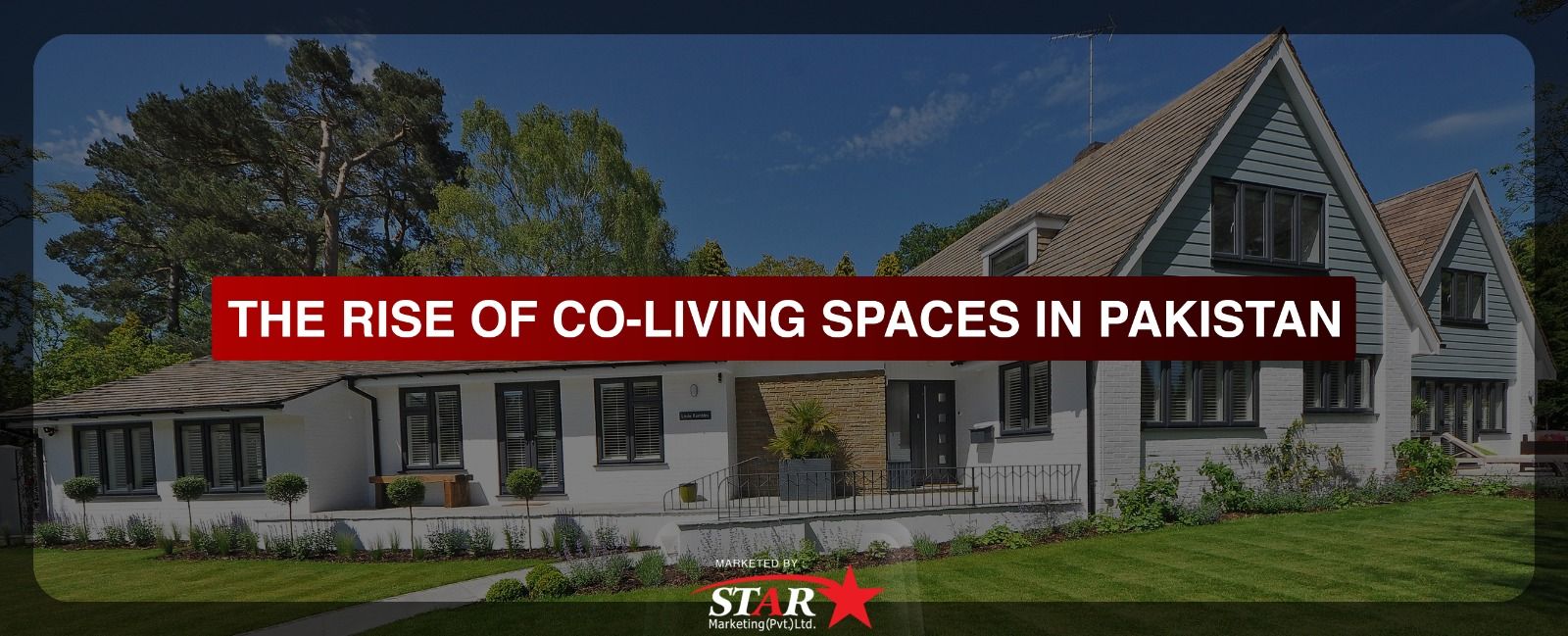

Recently, Pakistan has witnessed a significant rise in the popularity of co-living spaces, revolutionizing the way people approach shared accommodation. Co-living spaces, also known as shared living spaces or communal living, offer a distinguished living experience that unifies affordability, community, and convenience.
Today, in this article, you will explore the rise of co-living spaces in Pakistan, their benefits, the current landscape in major cities, the challenges faced, and the future of this emerging trend.
Definition of co-living spaces
Co-living spaces refer to residential properties where individuals or small groups rent private bedrooms or micro-apartments while sharing common areas such as kitchens, living rooms, and recreational spaces. These spaces are designed to foster a sense of community and encourage social interactions among residents.
brief overview of the concept of shared accommodation
Shared housing has been a popular housing option for decades, especially among students and young professionals seeking affordable living arrangements. However, co-living spaces bring a fresh perspective to the concept, offering enhanced amenities, curated experiences, and a greater focus on community building.
The evolution of the rise of co-living spaces in
Meanwhile, in Pakistan, with more people choosing different cities to pursue their careers and education, the idea of co-living spaces has started normalizing in almost every metropolitan city of Pakistan for the sake of a better quality of life. This influx of individuals has created a demand for affordable yet comfortable living spaces, leading to the emergence of co-living as a viable solution.
Benefits of Co-Living Spaces in Pakistan
Affordable living options
Co-living spaces provide an affordable alternative to traditional rental options, allowing individuals to live in desirable neighborhoods at a fraction of the cost. By sharing the rent and utility expenses, residents can enjoy significant savings while still having access to well-designed and fully furnished accommodations.
Community and social connections:
One of the key advantages of co-living spaces is the opportunity to build a strong sense of community. Residents often share similar lifestyles and interests, creating a supportive network of like-minded individuals. Co-living spaces organize social events, workshops, and networking sessions, fostering connections and friendships among residents.
Convenience and amenities:
Co-living spaces are designed to provide convenience and comfort to residents. They offer a range of amenities, such as high-speed internet, housekeeping services, laundry facilities, fitness centers, and communal areas for relaxation and entertainment. These amenities eliminate the hassle of managing household chores and enhance the overall living experience.
Flexibility and ease of living:
Unlike traditional rental agreements that often involve long-term commitments, co-living spaces offer flexible lease terms. Residents can opt for short-term stays, allowing them to adapt their living arrangements based on their evolving needs. This flexibility is particularly beneficial for students, professionals on short-term assignments, and individuals in transition.
Professional networking opportunities:
Co-living spaces attract a diverse group of residents, including entrepreneurs, freelancers, and professionals from various industries. This environment provides excellent networking opportunities, allowing residents to connect with like-minded individuals and potential collaborators. The shared spaces and events often become hubs for creativity, innovation, and professional growth.
Co-Living Spaces in Major Pakistani Cities
Co-living Spaces in Karachi
Karachi, the bustling metropolis of Pakistan, has seen a surge in the establishment of co-living spaces. These spaces cater to the diverse needs of the city’s residents, offering a range of options from budget-friendly accommodations to luxury co-living communities. Popular areas that cater to co-living spaces in Karachi include DHA, Gulistan-e-Johar, Gulshan-e-Iqbal, and the FB Area. These areas offer co-living spaces that boast modern amenities such as co-working spaces, gaming lounges, rooftop gardens, and communal kitchens, creating a vibrant and inclusive living experience.
Co-living Spaces in Lahore
Lahore, known for its rich cultural heritage, is also witnessing the rise of co-living spaces. In the heart of the city, co-living communities are quite successful in attracting residents seeking a blend of comfort, affordability, and social connections. These spaces offer a range of services, such as 24/7 security, on-site cafes, fitness centers, and regular community events.
Co-living Spaces in Islamabad
Islamabad, the capital city of Pakistan, is not far behind in embracing the concept of co-living. The city’s serene surroundings and growing population of professionals and expatriates have contributed to the emergence of co-living spaces. Premier co-living options in Islamabad may vary according to your requirements and budget. These spaces prioritize privacy, security, and modern amenities such as swimming pools, concierge services, and private study rooms.
Challenges and Solutions of Co-living Spaces in Pakistan
Regulatory and legal challenges
The establishment of co-living spaces often faces regulatory and legal hurdles. Government regulations and policies may not explicitly address the concept of co-living, leading to uncertainties and compliance issues. However, proactive engagement with regulatory authorities, industry associations, and policymakers can help establish a framework that ensures safety, compliance, and standardized operations.
Privacy concerns
Living in shared spaces can raise concerns about privacy. While co-living spaces promote community and social interactions, residents also value their individual privacy. To address these concerns, innovative solutions such as soundproofing measures, private sleeping pods, and smart lock systems have been introduced. Clear communication of privacy policies and the availability of private spaces within co-living communities are also essential to maintaining a sense of personal space.
Maintenance and management
Managing and maintaining co-living spaces requires efficient systems and dedicated staff. Ensuring cleanliness and maintenance of common areas is crucial to ensuring a pleasant living experience for residents. Implementing regular cleaning schedules, hiring skilled maintenance personnel, and utilizing technology for maintenance tracking and issue resolution can help streamline the management process. Additionally, fostering a culture of community responsibility by involving residents in the upkeep of shared spaces can contribute to a harmonious living environment.
Future of Co-Living Spaces in Pakistan
Growing demand and market potential
The rising demand for affordable and flexible living arrangements in Pakistan indicates a promising future for co-living spaces. As more individuals prioritize experiences over traditional ownership, the demand for well-designed, community-oriented living spaces is expected to increase. Developers and investors are recognizing the market potential and are actively exploring opportunities to cater to this evolving housing trend.
Expansion plans and new developments
Driven by the demand, co-living space providers are expanding their operations and venturing into new markets. With successful models established in major cities, there are plans to introduce co-living spaces in smaller cities and suburban areas. These expansions will offer individuals in various locations the opportunity to experience the benefits of shared living.
Incorporating sustainable and eco-friendly practices
As sustainability becomes a global priority, co-living spaces in Pakistan are also embracing eco-friendly practices. From energy-efficient appliances to waste management systems, these spaces are incorporating sustainability into their design and operations. By creating environmentally conscious living environments, co-living spaces contribute to a greener future.
Integration of technology for enhanced living experiences
Technology plays a vital role in shaping the future of co-living spaces. The integration of smart home systems, mobile apps for community engagement, and virtual concierge services enhances the overall living experience. Automated processes, such as online booking and maintenance requests, provide convenience and efficiency for both residents and management.
Who are the ideal occupants of co-living spaces in Pakistan?
Co-living spaces in Pakistan are best for:
- Young professionals are seeking affordable living options.
- Students are looking for a community-oriented living experience.
- Freelancers and digital nomads desiring a flexible and convenient housing solution.
- Expatriates and individuals in transition who need temporary accommodations.
- Individuals who value social connections and networking opportunities.
- People who prefer fully furnished and well-designed living spaces.
- Those who want to enjoy shared amenities and services without the hassle of managing them individually.
- Individuals who prioritize convenience and accessibility to urban areas.
- Those who appreciate the sense of community and shared experiences.
Conclusion
The rise of co-living spaces in Pakistan has redefined the concept of shared accommodation, offering affordable living options, fostering community, and providing convenient amenities. With the growing demand for flexible and community-oriented housing, co-living spaces are becoming increasingly popular in major Pakistani cities like Karachi, Lahore, and Islamabad. While there are regulatory challenges and privacy concerns to address, proactive measures and innovative solutions can help overcome these obstacles. The future of co-living spaces in Pakistan looks promising, with expansions, sustainable practices, and technological integration on the horizon.
FAQs:
Are co-living spaces only suitable for young professionals?
Co-living spaces cater to a diverse range of individuals, including young professionals, students, freelancers, and even families. The flexibility and affordability of co-living make it suitable for anyone seeking a community-oriented living experience.
Can families or couples live in co-living spaces?
Yes, families and couples can live in co-living spaces. Some co-living communities offer private rooms or apartments specifically designed for families, providing them with the benefits of shared living while maintaining their privacy and comfort.
What are the typical lease terms for co-living spaces?
Lease terms for co-living spaces vary depending on the provider. They can range from a few months to a year or longer. Short-term stays are also commonly available, providing flexibility for individuals with changing needs.
How do co-living spaces foster a sense of community?
Co-living spaces foster a sense of community by creating shared spaces, organizing social events, and encouraging resident interaction. These spaces often have communal kitchens, co-working areas, and recreational facilities where residents can connect and engage with one another.
Are co-living spaces more cost-effective than traditional rental options?
Co-living spaces can be more cost-effective than traditional rental options, especially in desirable locations. By sharing the rent and utilities, residents can enjoy significant cost savings. Additionally, the bundled amenities and services offered by co-living spaces eliminate the need for residents to individually manage and pay for various household expenses, further enhancing their cost-effectiveness.
What is the process for moving into a co-living space?
The process of moving into a co-living space typically involves several steps. Firstly, you would need to research and identify co-living spaces that align with your preferences, location, and budget. Once you have found a suitable space, you would usually need to reach out to the management or use an online platform to inquire about availability and schedule a viewing. During the viewing, you can assess the living environment and amenities and ask any questions you may have. If you decide to proceed, you would need to complete an application form, provide necessary documents such as identification and proof of income, and potentially pay a deposit or advance rent. The management would then review your application and, if approved, provide you with the lease agreement to sign. Prior to moving in, you may need to complete a move-in checklist and pay the remaining balance. On the agreed-upon move-in date, you would receive the keys and any necessary instructions to access your assigned living space within the co-living community.
Can I host events or parties in a co-living space?
Hosting events or parties in a co-living space may vary depending on the specific rules and policies of the co-living community. While some co-living spaces may have designated common areas or event spaces where residents can host gatherings, others may have restrictions or guidelines in place to ensure the comfort and well-being of all residents. It is important to inquire with the management or refer to the community guidelines to understand the specific regulations regarding hosting events or parties within the co-living space.
How do co-living spaces contribute to sustainable living practices?
Co-living spaces contribute to sustainable living practices in various ways. They often prioritize energy-efficient design and appliances, reducing overall energy consumption. Many co-living communities also implement recycling programs and encourage waste reduction. By sharing resources and amenities, such as communal kitchens and laundry facilities, co-living spaces promote efficient use of water and minimize individual carbon footprints. Additionally, the emphasis on community and shared experiences in co-living spaces fosters a culture of sustainability, where residents can collaborate on eco-friendly initiatives and collectively make a positive impact on the environment.



Leave a Reply